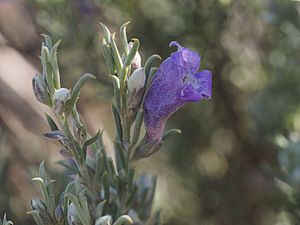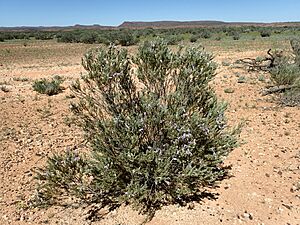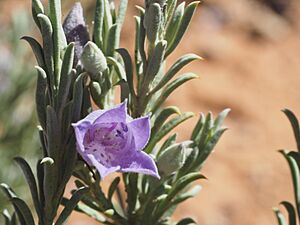Eremophila pantonii facts for kids
Quick facts for kids Eremophila pantonii |
|
|---|---|
 |
|
| Eremophila pantonii leaves and flowers | |
| Scientific classification | |
| Genus: |
Eremophila (plant)
|
| Species: |
pantonii
|
| Synonyms | |
|
|
Eremophila pantonii, also known as broombush, is a beautiful flowering plant that belongs to the figwort family. This special plant grows naturally only in Western Australia. It's a shrub that looks a bit like a broom, with many thin branches. Its leaves are narrow and have a small hooked tip. You can see its blue or purple, and sometimes white, flowers blooming in winter and spring.
Contents
What Does Broombush Look Like?
Eremophila pantonii is an upright shrub that can grow from about 0.7 to 3 meters (2 to 10 feet) tall. It has many branches that start right from the ground. Most parts of the plant, except for the petals, are covered in tiny, round, yellowish to grey scales.
Its branches are reddish-brown and have small, raised bumps. The leaves usually grow one after another along the branches. They are long and thin, with a hooked tip, measuring about 5 to 27 mm (0.2 to 1.1 inches) long and 1 to 3 mm (0.04 to 0.12 inches) wide.
The flowers usually grow alone or in pairs where the leaves meet the stem. Each flower sits on a short stalk, about 1 to 3 mm (0.04 to 0.12 inches) long. There are five green, egg-shaped sepals that overlap each other, about 3 to 5 mm (0.12 to 0.2 inches) long. The inside top half of these sepals is a bit hairy.
The petals are joined together at their bottom to form a tube, and they are about 17 to 30 mm (0.7 to 1.2 inches) long. This petal tube is usually lilac or purple, but sometimes it can be white. Inside the tube, it's white with yellow to brown spots. The outside of the petal tube and its tips are covered in branched hairs, and the inside of the tube is also hairy. The four stamens (the parts that make pollen) are completely hidden inside the petal tube.
Broombush flowers from May to September, and sometimes even into December. After the flowers, dry, oval-shaped, woody fruits appear. These fruits are about 4 to 6 mm (0.16 to 0.24 inches) long and are hairy.

How Broombush Got Its Name
The plant was first officially described by a scientist named Ferdinand von Mueller in 1882. He published his description in a science record book. The second part of its scientific name, pantonii, was chosen to honor Joseph Anderson Panton. He was recognized for his hard work over many years in helping to develop farming and understanding the geography of Australia.
Where Broombush Grows Naturally
Broombush is a common plant found across a wide area in Western Australia. You can find it between the towns of Laverton and Carnarvon. It grows in many different types of soil, often on flat areas or stony hills. You might see it growing in or near mulga woodlands, which are forests mainly made up of mulga trees.
Broombush and Its Animal Friends
One of the special animals that helps broombush make seeds is a native bee called Euhesma leonora. This bee is part of a group of insects known as Hymenoptera, which includes bees, wasps, and ants.
Is Broombush Protected?
The Western Australian Government's Department of Parks and Wildlife has looked at Eremophila pantonii. They have classified it as "not threatened," which means it is not currently in danger of disappearing.
Growing Broombush in Your Garden
This plant is a great choice for gardens because of its pretty silvery-grey leaves and its many pale lilac to purple flowers. It can be a standout plant or used to create a nice contrast with shrubs that have darker leaves.
Broombush is a tough shrub that has been grown successfully in most parts of Australia. Some plants have even lived for over 30 years! You can grow new broombush plants from seeds, from cuttings (small pieces of the plant), or by grafting it onto a Myoporum rootstock (another plant's root system).
It grows well in many different soils, including clay. It likes full sun or partial shade. It can handle very dry conditions and frost, making it a strong plant for many climates. You can also trim it lightly to keep it looking neat and compact.


